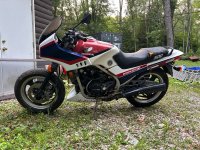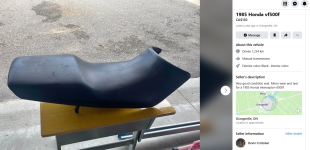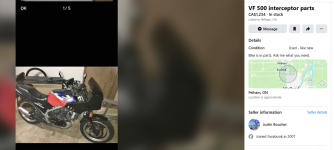I hesitate to post, especially as I don't have it in hand, but I am so excited. I struck a deal to buy a 500/V30 Interceptor this weekend. It's a bit of a haul.
That bike was my dream bike as a kid. I loved the original 750, but when the 500 came out, there as just something about it - the dimensions and color scheme were perfect. I had a picture of it in my locker right beside my pictures of pretty girls. Through all the years, it's always been there in my mind, like the girl I should have asked out.
Bike has issues for sure, including a few cosmetic ones, but it hasn't had the plastics spray painted over like most examples I see.
The owner informs me it turns over, has good compression and will try to start. He thinks it needs carbs cleaned or rebuilt due to it sitting with old gas for a long time. I talked to the guy for a good 45 minutes and felt like he was an old friend at the end of it.
I have no illusions that this is going to be an easy or even successful project - the V30 was only built for a few years, parts are hard to find (especially plastics; there seem to be quite a few Magnas kicking around), and there could be a ton of things wrong with it. Apparently things are very hard to get at on these bikes. I have no good space to work on it. And I am no expert wrench.
But it's the bike I dreamed of, at a price I could justify. And now I (almost) have one.
Anybody else here own a 500? I'm already trying to decide whether I should just go ahead and order a carb kit now.
That bike was my dream bike as a kid. I loved the original 750, but when the 500 came out, there as just something about it - the dimensions and color scheme were perfect. I had a picture of it in my locker right beside my pictures of pretty girls. Through all the years, it's always been there in my mind, like the girl I should have asked out.
Bike has issues for sure, including a few cosmetic ones, but it hasn't had the plastics spray painted over like most examples I see.
The owner informs me it turns over, has good compression and will try to start. He thinks it needs carbs cleaned or rebuilt due to it sitting with old gas for a long time. I talked to the guy for a good 45 minutes and felt like he was an old friend at the end of it.
I have no illusions that this is going to be an easy or even successful project - the V30 was only built for a few years, parts are hard to find (especially plastics; there seem to be quite a few Magnas kicking around), and there could be a ton of things wrong with it. Apparently things are very hard to get at on these bikes. I have no good space to work on it. And I am no expert wrench.
But it's the bike I dreamed of, at a price I could justify. And now I (almost) have one.
Anybody else here own a 500? I'm already trying to decide whether I should just go ahead and order a carb kit now.





















